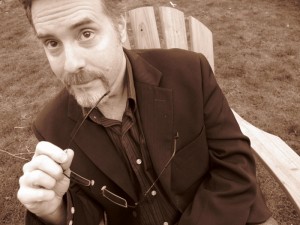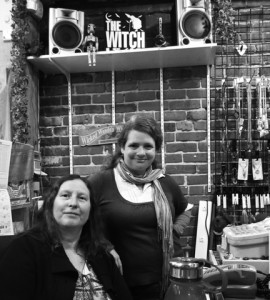Victoria has often been dubbed a haven for newlyweds and nearly deads, but there’s another cultural group thriving in Mile Zero: witches. From followers of the Wiccan faith to ceremonial magicians and goddess worshippers, those who practice pagan traditions abound in Victoria.
John Threlfall, fine arts communications and special projects officer at the University of Victoria, has long been an advocate of the Victoria Wiccan community.
“People know me as the local witch,” says Threlfall, who has been practicing witchcraft for over 28 years. “One of the reasons I moved to Victoria was because it was such an ‘out’ witch town. I knew, living in Vancouver, that Victoria was where it was at.”

But it wasn’t always so inviting. Thanks to attention from such sources as Michelle Remembers, a so-called true account of Satanic rituals and child abuse, Victoria has a history of misconceptions about witches and their practices.
“People used to, and probably still do in some circles, associate witches with other fictional Halloween characters like vampires and werewolves,” says Threlfall. “They think witches don’t really exist, not realizing it’s a legally recognized religion.”
Thanks to the work of Threlfall and other members of the Wiccan community who work to educate the public, Victoria has become something of a Pagan paradise.
“Being a witch in Victoria is like being gay in San Francisco. We’re very much understood and accepted as part of the community,” says Threlfall.
While Threlfall belongs to the local 13th House Mystery School, Robert Birch, gay men’s health coordinator for AIDS Vancouver Island, practices in the Reclaiming tradition. Reclaiming is strongly based in feminism and activism and, for Birch, participating in the tradition sends an important message.
“Identifying myself as a witch is a counterculture way of reclaiming my own identity and pushing back from a neo-Christian upbringing,” says Birch. “A lot of people that attend Reclaiming are what I call cultural change agents. They are actively looking at making a more egalitarian society for us and for the planet.”
One of the ways Birch and other members of the Reclaiming community work to make change is through the skill-sharing workshops and presentations offered at the annual BC Witchcamp. Celebrating its 25th anniversary this year, BC Witchcamp provides novice and experienced witches a week of learning, eating, playing, and dancing in the forests of the Lower Mainland. It was at a Witchcamp in California where Birch was inspired to commit to the practice of witchcraft.

“150 people dancing around a fire every night, really exploring these deep, soulful, body-centered, heart-centered experiences is mind-blowing,” says Birch.
Now, as a teacher at BC Witchcamp, Birch enjoys the opportunity to explore the facets of his personality.
“It’s a great place for me to share my skills as a workshop facilitator and trainer, but also play as an artist and a performer,” he says.
Back in Victoria, those interested in a less intensive first step into the craft can take the Introduction to Wicca course taught by members of the 13th House Mystery School at Triple Spiral in Fan Tan Alley.
Phylis Songhurst, longtime proprietor of Triple Spiral and Priestess in 13th House Mystery School, explains that the lure of the unknown attracts people to the biannual course.
“Some people know there is something else, but they don’t know how to find it and they’re looking for how to connect,” she says. “Sometimes people will have strong intuition or psychic ability and they don’t know what to do with that. They might think, ‘These things are happening and I don’t know why.’”
While the course, which is open to anyone over the age of 19, covers topics such as spellcraft, herbology, and history, the Wheel of the Year is one of the central structures in many Wiccan practices. Based on the transition of the seasons, the Wheel of the Year consists of eight festivals, with the New Year, or Samhain (pronounced sow-en), falling around October 31. Samhain, the basis for some traditions still practiced on Halloween, is a time for honouring the dead and celebrating the birth of a new year.
For Threlfall, who’s not only an active witch but a busy dad, the end of October means making time for all celebrations.
“We’re like any other modern family that has to grapple with the consumer and the spiritual traditions,” he says. “But Halloween is the only night of the year when it’s cool to be a witch. It’s our one night of the year that’s all about us.”
Witch discrimination
Even though Victoria has a large number of Wiccans and practicing witches, it’s not nearly as accepted as most mainstream religions. Take a recent request by Corrections Canada in BC for a Wiccan prison chaplain. In early September, Canada’s public safety minister Vic Toews turned down the request on the grounds that all non-Christian chaplains were to be eliminated based on his interpretation of the prison chaplain policy. This leaves all Wiccan prisoners in BC with the only option of chaplain services coming from a Christian chaplain. Pagans getting spiritual guidance from Christians? Trick or treat!
-JASON SCHREURS
The witch myth
Ever wonder why the traditional Halloween imagery of a witch involves them riding on a broomstick? Well, thanks to the theory of the late Barry Beyerstein, a scientific skeptic and psychology professor at Simon Fraser University, you may never look at a witch’s broomstick the same. Beyerstein believed that the sensation of flying experienced by witches was the result of boiling and ingesting the deadly nightshade plant, which produced a hallucinogenic reaction. Since the effect was the result of the plant entering the bloodstream, the legend that witches flew on broomsticks might have been the result of the witches rubbing the broomsticks they had used to mix the boiled nightshade solution against their vaginal regions, thus a broomstick between their legs. Yes, folks, their vaginal regions. Local witch John Threlfall isn’t necessarily buying this theory, though.
“Since the use of hallucinogens in early witchcraft practice has been widely theorized, there may be a case for Beyerstein’s ideaŃalthough you have to wonder who’d be mixing a boiling solution with a broom,” he says. “Why not just use a wooden spoon? But it seems to have a bit of a gender bias, obviously precluding the involvement of male witches… unless they were doing something more intimate with their magic wands.”
“A more realistic argument for broom riding can be found in early agricultural fertility traditions,” he continues, “where pagans would straddle their brooms, often used in marriage ceremonies, and see how high they could leap in freshly planted fields: the higher the leap, the bigger the crop. It’s easy to imagine how a scene like this could trickle down to the stereotypical witch-on-broom imagery. Do witches still use brooms today? AbsolutelyŃin ritual, for handfasting marriage ceremonies, as decorations and, not too surprisingly, simply for sweeping their homes.”
-JASON SCHREURS

Really intrigued buy all if it!
Are there any Wicca activities in Victoria, BC?
Thanks!
Keep your eyes peeled on our Nov. 2, 2016 issue for more witch information!
I was wondering when the witch camp happens